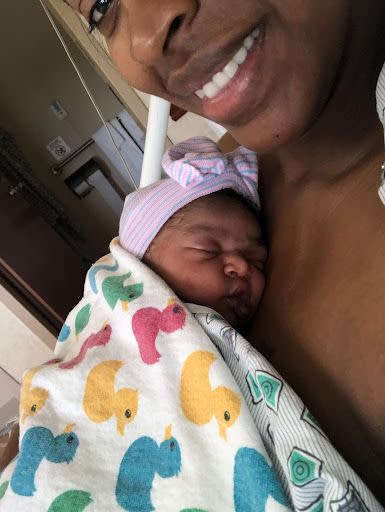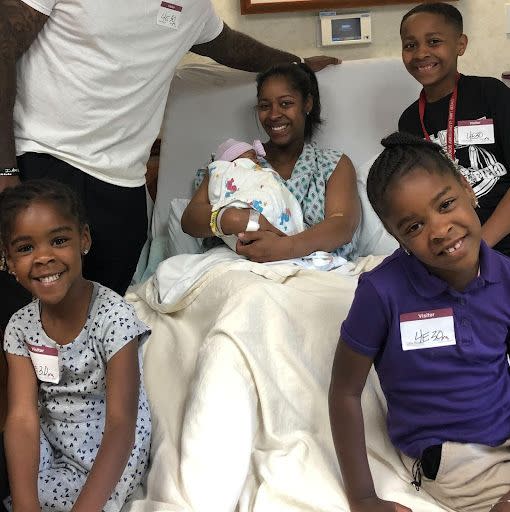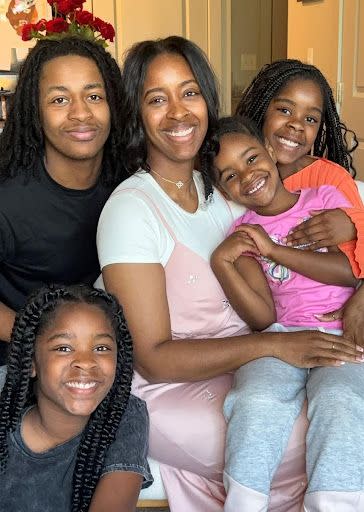‘Doctors Misdiagnosed My Postpartum Symptoms As Pneumonia, But It Was A Serious Heart Condition’

My fourth pregnancy was just like the other three—totally seamless. In fact, it was the easiest of all my pregnancies in terms of how well I was feeling throughout. I was pretty much a pro at this by now. Much of the beginning of the postpartum period went as smoothly as possible, too.
Just about six and a half months later, everything started to change. I began experiencing odd symptoms, like intense fatigue, swelling in my legs and ankles, and bloating in my belly. Initially, I thought, I’m a busy working mom, I’m used to being tired, and I didn’t give it too much thought otherwise. But I constantly felt like I needed to rest, which didn’t feel normal. Then, what happened next scared me.
One day at work, I briefly blacked out. That’s when I knew something was wrong.
I exited the elevator to go to the cafeteria and get lunch, and lost my vision for a moment. The room went black and I stood off to the side, against the wall, not wanting anyone to notice what was going on and cause a scene. It felt like it took forever to pass, but I stayed still until I felt slightly less dizzy. That brief loss of vision is what prompted me to make an appointment to get some answers about my other symptoms, like the swelling, bloating, and fatigue.
Initially, doctors didn’t see anything diagnosable. The first physician I went to was a general practitioner I was already familiar with. They told me there was nothing concerning given my medical or family history and that my symptoms were just something to keep an eye on. I didn’t get any real answers.

After I left that first appointment, I was experiencing more leg and ankle swelling and grew more tired. I decided I didn’t feel comfortable with “keeping an eye on the symptoms” myself and wanted a new set of eyes to take a look, so I went to see another general practitioner. At the second appointment, the physician emphasized that I was young and healthy, and that there was a virus going around, so I should wait and see if the fatigue, bloating, and dizziness passed in a few days. Spoiler alert: They didn’t. My symptoms, including the development of congestion, just kept getting more severe, to the point where I considered going to the emergency room.
I went to the ER and they treated me for pneumonia, but I kept getting worse.
Because I was experiencing muscle fatigue, labored breathing, and congestion that made it difficult to lay down flat to rest, the ER staff did a bunch of tests on me, and the doctor there misdiagnosed me with pneumonia. I then asked a bunch of questions, including “How does someone who’s typically healthy receive a diagnosis of pneumonia?” It didn’t make sense.
Pneumonia at a glance: Anyone can get pneumonia, and it is one of the most common illnesses with millions of people diagnosed each year in the United States alone. You may be at increased risk if you’re over age 65, are living with a lung or heart condition, are pregnant, and/or have a weakened immune system, per Cleveland Clinic. Bacterial pneumonia can occur when the body is weakened in some way (think: illness, poor nutrition, old age, or impaired immunity), while viral pneumonia, which is responsible for about one-third of all pneumonia cases, can occur from viruses like influenza, per Johns Hopkins Medicine.
I went home to try to treat myself for the pneumonia, but my health severely declined. All this time l was still living my life with my children, my career, and going to work. Finally I felt so bad that I took my first sick day from work. I was used to pushing through, but I knew how bad this was. I had this voice in the back of my mind that said, If you don’t figure this out today, this is it. At that point, I sat on the edge of my bed with my insurance card and called the number on the back to get a referral to another physician. It was the week of Thanksgiving 2019, so most physicians were already out of office for the holiday.
Finally, I got an appointment and dragged myself to it—walking was difficult, it was even more challenging to breathe, and my legs hardly worked. The nurse brought me back, and knew right away that something wasn’t right.

It took me four doctors to finally find out I was experiencing heart failure.
The fourth doctor, general practitioner Lynsie Bane, MD, at Mount Carmel Medical Group in Ohio, ran an electrocardiogram (EKG) on me and determined that I was most likely in heart failure and needed to go to the hospital. I went to Mount Carmel Medical Group hospital, and there, cardiologist Thomas P. Archer, MD, diagnosed me with peripartum cardiomyopathy, a weakening and malfunctioning of the heart that can cause symptoms like swelling and fluid buildup during the last month of pregnancy or in the first few months postpartum. Doctors don’t really know what causes the condition besides pregnancy putting strain on the heart.
What is peripartum cardiomyopathy? In the U.S., peripartum cardiomyopathy affects between 1 in 1,000 and 1 in 4,000 pregnancies, per Cleveland Clinic. The cause of cardiomyopathy is not always known, but it can occur due to other conditions like coronary artery disease, a viral infection in the heart, and more, per Johns Hopkins Medicine. To make an accurate diagnosis of peripartum cardiomyopathy, these conditions must be excluded if a woman is showing symptoms during the peripartum period.
My initial response to hearing I was in heart failure was fear. The first question in my mind was, Am I going to see my kids again? I was trying to figure out if I could have caught it earlier, but also I was trying to figure out what life was going to look like after I was admitted into the hospital. There was immediate concern for my family because I always put my family first. My maternal instinct kicked in, and I started thinking, I have to take care of everyone else, I can’t be down like this, my kids need to be picked up from school. But I knew that if there was anything I could do that was within my power, it was to fight for my life.

As hard as it was, I had to take a step back and focus on my own health.
Being in the hospital for over two weeks meant that I had to stop breastfeeding my baby, which I had been doing for the past six months, that same day; I didn’t know until then that nursing my child was putting additional strain on my heart because of this condition. Caretaking for my children and everything else had to pause—I was ready to do whatever the doctor said I needed to do. My cardiologist (Dr. Archer) put together and discussed a treatment plan with me, taking inventory on all the areas of my life, including asking about my stress levels. I knew at that time that juggling my diagnosis with my family and career was a trigger for my heart health. So I decided to realign some things, sought out therapy, and made more time for self-care.
Other parts of my treatment plan included heart medication, a low-sodium diet to reduce the risk of retaining fluids, which can contribute to heart failure, and plenty of exercise. But the most important piece was the mental health aspect, including therapy and taking more time for myself.
Most days, I don’t experience any symptoms of cardiomyopathy. My health has improved significantly in the five years since I gave birth, but I still adhere to a daily treatment plan that involves medication, exercise, a low-sodium diet, monthly check-ins with my therapist, and other wellness activities, including meditation, journaling, and intentional rest. Now, I plan and prioritize my health in every aspect of my life.

I don’t want other new moms to think their uncomfortable symptoms are “normal.”
The truth is that heart disease doesn’t discriminate, and can affect you at any age. At the time, I was only 35, and I was thinking, I am young, and I feel great. Something so serious couldn’t happen to me.
I want new moms to know that prioritizing themselves is so important. We get lost in all of the things that we do for others, and don't allow time for ourselves. We shouldn’t get used to not feeling great as our new normal, especially after having children. You deserve to feel your best—and if you don’t, you need to advocate for yourself and don’t take no for an answer, from any doctor. Ironically, I encouraged my parents to get screened, and cardiovascular health issues have shown up for my mom after my own diagnosis. Get as many second opinions as you need until you are heard.
Your health is what you have as a mother. You can’t perform all the other tasks in your life if you’re not well. Remember that your whole self is part of your identity, and you need to make sure you’re able to show up for both yourself and your family.
You Might Also Like
